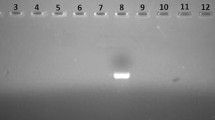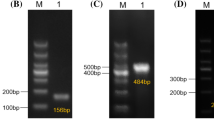Abstract
Toxin producing Bacillus cereus can cause enterotoxic and/or emetic food poisoning. In the present study, a multiplex PCR assay was developed to detect all toxin genes known to be involved in food poisoning of B. cereus in a single reaction. Specific primers for the detection of enterotoxic (entFM, hblC, nheA, and cytK) genes and emetic toxin production (2 primer pairs: ces, CER) were designed based on the GeneBank sequences. The developed multiplex PCR assay was evaluated in pure culture and artificially inoculated milk, using 43 B. cereus strains and non-target strains. In brief, sensitivity in pure culture was 10-fold or more higher than artificially inoculated milk in multiplex PCR detection limit assay. The presented PCR assay is a developed molecular tool for the rapid simultaneous detection of emetic and enterotoxin producing B. cereus strains.
Similar content being viewed by others
References
Fang TJ, Chen CY, Kuo WY. Microbiological quality and incidence of Staphylococcus aureus and Bacillus cereus in vegetarian food products. Food Microbiol. 16: 385–919 (1999)
Schoeni JL, Wong ACL. Bacillus cereus food poisoning and its toxins. J. Food Protect. 68: 636–648 (2005)
Bartoszewicz M, Hansen BM, Swiecicka I. The members of the Bacillus cereus group are commonly present contaminants of fresh and heat-treated milk. Food Microbiol. 25: 588–596 (2008)
Ash C, Farrow JA, Dorsh M, Stackebrandt E, Collins MD. Comparative analysis of Bacillus anthracis, Bacillus cereus, and related species on the basis of reverse transcriptase sequencing of 16S rRNA. Int. J. Syst. Bacteriol. 41: 343–346 (1991)
Carlson CR, Caugant DA, Kolsto AB. Genotipic diversity among Bacillus cereus and Bacillus thuringiensis strains. Appl. Environ. Microb. 60: 1719–1725 (1994)
Henderson I, Dongzheng Y, Turnbull PCB. Differentiation of Bacillus anthracis and other Bacillus cereus group using IS231-derived sequences. FEMS Microbiol. Lett. 128: 113–118 (1995)
Stephan R. Randomly amplified polymorphic DNA (RAPD) assay for genomic fingerprinting of Bacillus cereus isolates. Int. J. Food Microbiol. 31: 311–316 (1996)
Borin S, Daffonchio D, Sorlini C. Single strand conformation polymorphism analysis of PCRtDNA fingerprinting to address the identification of Bacillus species. FEMS Microbiol. Lett. 157: 87–93 (1997)
Nilsson J, Svensson B, Ekelund K, Christiansson A. A RAPD-PCR method for large-scale typing of Bacillus cereus. Lett. Appl. Microbiol. 27: 168–172 (1998)
Shangkuan YH, Yang JF, Lin HC, Shaio MF. Comparison of PCRRFLP, ribotyping, and ERIC-PCR for typing Bacillus anthracis and Bacillus cereus strains. J. Appl. Microbiol. 89: 452–462 (2000)
Drobniewski FA. Bacillus cereus and related species. Clin. Microbiol. Rev. 6: 324–338 (1993)
Kotiranta A, Lounatmaa K, Haapasalo M. Epidemiology and pathogenesis of Bacillus cereus infection. Microb. Infect. 2: 189–198 (2000)
Beecher DJ, MacMillan JD. A novel bicomponent haemolysin from Bacillus cereus. Infect. Immun. 58: 2220–2227 (1990)
Kim JB, Kim JM, Cho SH, Oh HS, Choi NJ, Oh DH. Toxin genes profiles and toxin production ability of Bacillus cereus isolated from clinical and food samples. J. Food Sci. 76: 25–29 (2011)
Ehling-Shulz M, Fricker M, Scherer S. Identification of emetic toxin producing Bacillus cereus strains by a novel molecular assay. FEMS Microbiol. Lett. 232: 189–195 (2004)
Toh M, Moffit MC, Henrichsen L, Raftery M, Barrow K, Cox JM, Marquis CP, Neilan BA. Cereulide, the emetic toxin of Bacillus cereus, is putatively a product of nonribosomal peptide synthesis. J. Appl. Microbiol. 97: 992–1000 (2004)
Kramer JM, Gilbert RJ. Bacillus cereus and other Bacillus species. pp. 22–70. In: Foodborne Bacterial Pathogens. Doyle MP (ed). Marcel Dekker Inc., New York, NY, USA (1989)
Yang IC, Shih DY, Huang TP, Huang YP, Wang JY, Pan TM. Establishment of a novel multiplex PCR assay and detection of toxigenic strains of the species in the Bacillus cereus group. J. Food Protect. 68: 2123–2130 (2005)
Lund T, de Buyser ML, Granum PE. A new cytotoxin from Bacillus cereus that may cause necrotic enteritis. Mol. Microbiol. 38: 254–261 (2000)
Dierick K, van Coillie E, Swiecicka I, Meyfroidt G, Devlieger H, Meulemans A, Hoedemaekers G, Fourie L, Heyndrickx M, Mahillon J. Fatal family outbreak of Bacillus cereus-associated food poisoning. J. Clin. Microbiol. 43: 4277–4279 (2005)
Kim JB, Kim JM, Kim YS, Kim JH, Park YB, Choi NJ, Oh DH. Comparison of enterotoxin production and phenotypic characteristics between emetic and enterotoxic Bacillus cereus strains. J. Food Protect. 73: 1219–1224 (2010)
Kramer JM, Gilbert RJ. Bacillus cereus gastroenteritis. pp. 119–153. In: Food Poisoning-Handbook of Natural Toxins. Marcel Dekker Inc., New York, NY, USA ( 1992)
Aas N, Gondrosen B, Langeland G. Norwegian Food Authorities Report on Food Associated Diseases in 1990. 1992 SNT Report 3, Oslo, Norway (1992)
Schmidt K, Tirado C. WHO Surveillance Program for Control of Foodborne Infections and Intoxications in Europe (7th Report 1993–1998) 110. World Health Organization, Berlin, Germany (2001)
Kim JB, Kim JM, Kim CH, Seo KS, Park YB, Choi NJ, Oh DH. Emetic toxin producing Bacillus cereus Korean isolates contain genes encoding diarrheal-related enterotoxins. Int. J. Food Microbiol. 144: 182–186 (2010)
Hall JA, Goulding JS, Bean NH, Tauxe RV, Hedberg CW. Epidemiologic profiling: Evaluating foodborne outbreaks for which no pathogen was isolated by routine laboratory testing: United States, 1982–9. Epidemiol. Infect. 127: 381–387 (2001)
Buchanan RL, Schultz FJ. Comparison of the Tecra VIA kit, Oxoid BCET-RPLA kit and CHO cell culture assay for the detection of Bacillus cereus diarrhoeal enterotoxin. Lett. Appl. Microbiol. 19: 353–356 (1994)
Jang JH, Lee NA, Woo GJ, Park JH. Prevalence of Bacillus cereus group in rice and distribution of enterotoxin genes. Food Sci. Biotechnol. 15: 232–237 (2006)
Guinebretiere MH, Broussolle V, Nguyen-The C. Enterotoxigenic profiles of food-poisoning and food-borne Bacillus cereus strains. J. Clin. Microbiol. 40: 3053–3056 (2002)
Kim JB, Park JS, Kim MS, Hong SC, Park JH, Oh DH. Genetic diversity of emetic toxin producing Bacillus cereus Korean strains. Int. J. Food Microbiol. 150: 66–72 (2011)
Ehling-Schulz M, Guinebretiere MH, Monthan A, Berge O. Toxin gene profiling of enterotoxic and emetic Bacillus cereus. FEMS Microbiol. Lett. 260: 232–240 (2006)
Stenfors LP, Granum PE. Psychrotolerant species from the Bacillus cereus group are not necessarily Bacillus weihenstephanensis. FEMS Microbiol. Lett. 197: 223–228 (2001)
Harwood PF, Burgess GW, Oakey HJ. Evidence for none-ribosomal peptide synthetase production of cereulide the emetic toxin in Bacillus cereus. FEMS Microbiol. Lett. 236: 319–324 (2004)
Kim JH, Lim EG, Jang HC, Park JY, Lee SJ, Park MS, Chli GB, Lee BK. A case of emetic toxin producing Bacillus cereus strains isolated from outbreak. Korean J. Clin. Microbiol. 12: 48–52 (2009)
Agata N, Ohta M, Yokoyama K. Production of Bacillus cereus emetic toxin (cereulide) in various foods. Int. J. Food Microbiol. 73: 23–27 (2002)
Ngamwongsatit P, Busari W, Pianariyanon P, Pulsrikarn C, Ohba M, Assavanig A, Panbangred W. Broad distribution of entertoxin genes (hblCDA, nheABC, cytK, and entFM) among Bacillus thuringiensis and Bacillus cereus as shown by novel primers. Int. J. Food Microbiol. 121: 352–356 (2008)
Tran SL, Guillemet E, Gohar M, Lereclus D, Ramarao N. CwpFM (entFM) is a Bacillus cereus potential cell wall peptidase implicated in adhesion, biofilm formation, and virulence. J. Bacteriol. 192: 2638–2642 (2010)
Alarcon B, Vicedo B, Anzar R. PCR-based procedures for detection and quantification of Staphylococcus aureus and their application in food. J. Appl. Microbiol. 100: 352–364 (2005)
Lee MD, Fairchild A. Sample preparation for PCR. pp. 41–50. In: PCR Methods in Foods. Maurer JJ (ed). Springer, New York, NY, USA (2006)
Author information
Authors and Affiliations
Corresponding author
Rights and permissions
About this article
Cite this article
Kim, JM., Forghani, F., Kim, JB. et al. Improved multiplex PCR assay for simultaneous detection of Bacillus cereus emetic and enterotoxic strains. Food Sci Biotechnol 21, 1439–1444 (2012). https://doi.org/10.1007/s10068-012-0189-8
Received:
Revised:
Accepted:
Published:
Issue Date:
DOI: https://doi.org/10.1007/s10068-012-0189-8




